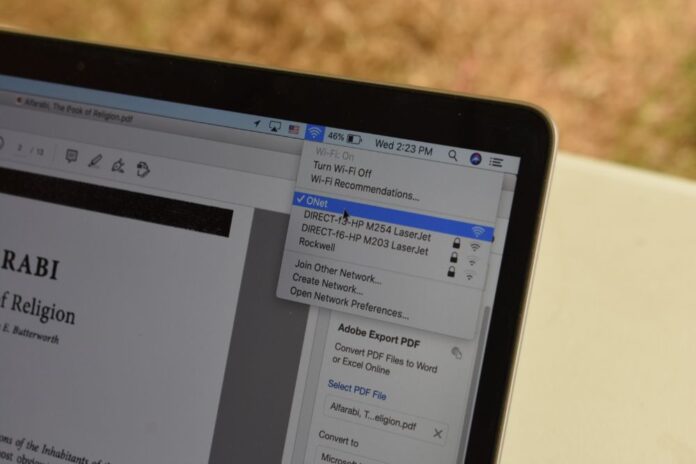
Over the pandemic, Information Technology Services (ITS) was busy making changes to the college’s WiFi registration system, extending access to outdoor tent classrooms and increasing capacity, according to Vice President for Information Technology Services and Chief Information Officer (CIO) James Uhrich. During the time away, ITS also reassessed what the student body’s wireless needs and requirements would be when they returned to campus.
“We understood what wireless and network usage looked like pre-pandemic,” Uhrich said. “[But] this is all new. People’s computing habits may be different now. The types of devices they have may be different now. How and what they use may be different now.”
According to Director of Technical Services Steven Gilman ’01, another change in response to the pandemic is that Occidental’s wireless network, ONet, no longer requires a username and password registration to access.
“We turned that [registration] off during COVID to simplify our network. We were having some issues with BlueJeans, which was our Zoom at the time, and we weren’t sure what was going on. And it was COVID, so we were throwing anything we could at the wall,” Gilman said.
According to Uhrich, the plan is to turn the registration system back on as early as this semester. Uhrich said it was not turned back on before the fall semester because ITS did not want to make the return to campus more complex and the wait gives them more time to explore the possibility of turning on other security features. Having a registration system is best practice since if there is an issue — whether someone is illegally downloading something or there is a security issue — ITS will have an easier time locating a registered device, according to Uhrich.
“Everyone wants everything to be secure, but they also want everything to work. So we balance that a bit,” Gilman said. “Ease of use versus security. The more secure you make something, the harder it is to use.”
In response to the unknown variables ITS has faced with students returning to campus, Uhrich said the department focused on increasing wireless capacity so more devices can use the Wi-Fi at once. According to Uhrich, ITS also installed another controller box in the wireless server room to create redundancy — the ability to survive a system failure by making additional resources available to fall back on.
“If you have redundancy, then when one of the things breaks, the other thing takes over, and it spreads out the workload, so more than one thing is doing the work,” Uhrich said. “It makes the wireless run better. That doesn’t necessarily mean students are going around saying they love the redundancy. It’s a behind-the-scenes improvement.”
Occidental’s new outdoor tent classrooms required the installation of 10 additional Wi-Fi access points, according to Gilman. Gilman said if a student looks closely at any of the tents, they will see a wire that runs to an indoor space. There are 780 access points on campus, according to Gilman.
Uhrich said ITS plans to increase wireless access in non-building areas. While there was construction on Gilman Fountain and Sycamore Glen, ITS took the opportunity to install underground tubes to protect electrical wiring in these areas, according to Uhrich. Uhrich said ITS can now install wireless access points in those outside areas in the future.
To have excellent Wi-Fi on the Academic Quad, for example, ITS would have to run a wire outside in that area, and it would be difficult for Facilities Management to accomplish this without a construction project, Uhrich said.
“If we were tearing up the [Academic] Quad, we would certainly add [wireless], but other than that, it’s hard because it needs to be permanent and aesthetically pleasing,” Gilman said. “Wireless is invisible, and people expect it to be hidden and ubiquitous, and so aesthetically, it’s not acceptable to have a big trash can looking thing, or a cell tower in the middle of the campus.”
Dominic Rios (junior) said when he returned to campus, there were times when he was in Stewart-Cleland Hall and Johnson Hall and did not have access to a strong Wi-Fi signal using ONet. Rios also said he hopes for better wireless connection on the Academic Quad, so students do not have to use their data and pay extra.
“Having Wi-Fi is really important. The pandemic highlighted the inequality within people’s lives, particularly at home,” Rios said. “At Oxy it should be more neutral.”
According to Uhrich, ITS has not received an onslaught of complaints about WiFi this year, but he realizes they may not be hearing complaints if people are not reaching out about issues. Anyone can file a complaint by contacting the Technology Help Desk, according to Uhrich, and he said he hopes people will feel comfortable communicating with ITS so they can address any service issues.
“He’s [Gilman’s] an alumnus who wakes up every day thinking about this place, and he loves this place, and he went to school here and he comes and puts his heart and soul into it. So that’s how we [ITS] approach our work,” Uhrich said.
![]()



































